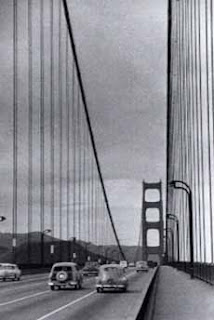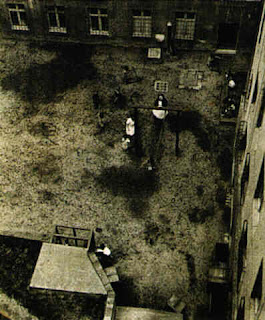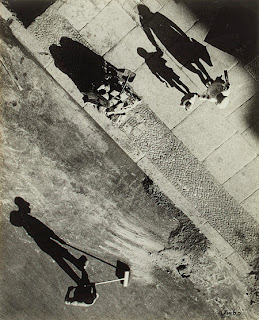Umbo - Dreamers
(Modernism in Central Europe - Exhibition at the Washington National Gallery)
This photo, Dreams, brought into my mind the works of Chirico and Magritte. Their mannequins, faceless bodies, in a mute dialog with these masks, bodiless faces. The same theatrical universe, of props stored somewhere in a tiny closet, dreaming at the lights of the stage. Dolls dreaming at the joy of kids playing with them in large rooms fool of light. Heads dreaming at shoulders of greatly dressed mannequins, standing in large windows.
Aren't they actually, these bodiless faces, our dreams? Or our memories? Our hopes? Our fears?
Umbo (Otto Umbehr) was one of the most important photographers to emerge from the Bauhaus. Perhaps the second, after Moholy-Nagy.
Here is another work of Umbo, Der rasender Reporter, made in 1926. The raging reporter is Egon Erwin Kisch.

Umbo was trained at the Bauhaus from 1921-3 with Johannes Itten, Oskar Schlemmer and Wassily Kandinsky. He moved then to Berlin where he was camera assistant to Walter Ruttmann for his masterpiece, Berlin, Die Sinfonie einer Grosstadt. In 1926 Umbo began a career as a professional photographer, opening a portrait studio with the assistance of Paul Citroën. From 1928-33 he worked for Dephot, (Deutsche Photodienst), the first cooperative photojournalist agency. He experimented with multiple exposure, unusual camera angles, photomontage, collage, and x-ray film. He took part in FiFo (Film und Foto), the important international exhibition of avant-garde photography and film held in Stuttgart in 1929 (Catalogue of Cleveland Museum of Art).
This close-up of a Cat dates from 1927.

Here are two photographs made by Umbo in San Francisco, at the beginning of the 50s.


Umbo was a soldier in the Second World War, while bombs destroyed his Belin studio and 60,000 negatives. He returned to work as a photographer until 1957 when he took up teaching. It is only relatively recently that much of his old work has come to light again, including some previously forgotten close-up portraits, photomontage and photograms from the 20s as well as his classic photojournalism from the 30s (Directory of Notable Photographers).
Here are two other works by Umbo: a Simultaneous Portrait (1927), and a Playground (1928):


And I left for the end his masterpiece: Mysterium der Strasse. Plato brought us Socrate's Allegory of the Cave ... and because of flickering he would be not able to see the objects for which he had seen the shades before ...
This photograph does not describe what Otto Umbehr saw when he looked out his window in Berlin, but what he discovered when he turned his overhead view of the street upside down. His simple inversion (indicated by his signature Umbo in the lower right corner) posits an unsettling world in which the insubstantial dominates the substantial, and imagination intercepts cognition (MetMuseum).
Chirico comes again to mind: Mystère et mélancolie d'une rue ... everywhere, a threat, harrowing ... but it's only a dream ... you open your eyes ... everything's fine ... it was a dream ... you close your eyes ... only you know that the nightmare will visit you again ... and again ... and again ...

(Modernism in Central Europe)
Labels: Chirico


0 Comments:
Post a Comment
<< Home